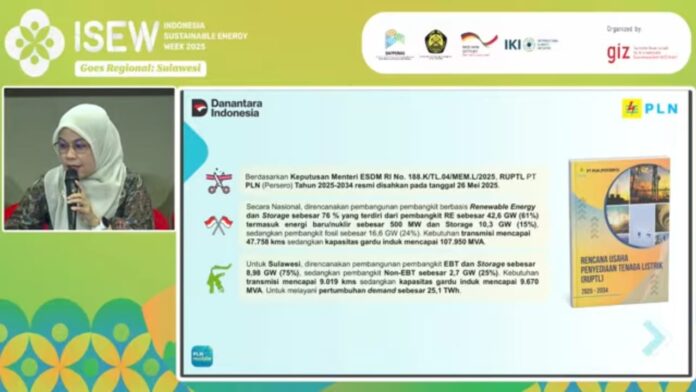Ecobiz.asia — PT PLN (Persero), Indonesia’s state-owned electricity firm, is set to develop approximately 9,000 circuit kilometers (KMS) of new transmission lines across Sulawesi as part of its Electricity Supply Business Plan (RUPTL) 2025–2034.
The expansion is aimed at improving grid reliability and meeting the island’s growing electricity demand.
Andi Murniawati, Senior Manager for Planning at PLN’s Sulawesi Generation and Transmission Unit (UPJB Sulawesi), said the transmission network will be significantly enhanced, with the new lines boosting Sulawesi’s transmission capacity by 1.5 times compared to the current 6,000 KMS.
“This expansion will significantly improve grid performance and help meet Sulawesi’s rising energy needs,” she stated during the Indonesia Sustainable Energy Week 2025 event in Makassar, Thursday (Oct 30, 2025).
PLN also plans to upgrade substation capacity from 6,600 megavolt amperes (MVA) to nearly 10,000 MVA, in anticipation of an annual electricity demand growth of around 25 terawatt hours (TWh).
The expansion is part of PLN’s strategy to integrate electricity systems across eastern Indonesia, ensuring more robust connectivity and supporting the country’s clean energy transition.
Under the RUPTL 2025–2034, 75 percent of new power plants in Sulawesi will be based on renewable energy and storage, contributing around 8.98 gigawatts (GW). The remaining 25 percent will come from non-renewable sources.
Additionally, PLN plans to install Battery Energy Storage Systems (BESS) with a total capacity of nearly 1.6 GW across the northern and southern Sulawesi grids. These systems are expected to stabilize the grid and manage renewable energy fluctuations, such as from solar and wind sources.
Currently, Sulawesi’s power network operates as two separate grids, northern and southern, which are not interconnected. PLN plans to complete the interconnection project by 2028, following the construction of major transmission infrastructure.
“Once the two systems are connected, we will conduct a system stability study, as linking two large grids over long distances with limited demand in between presents unique challenges,” said Andi.
PLN has also projected demand growth across Sulawesi’s six provinces, with Central Sulawesi, Gorontalo, South Sulawesi, and Southeast Sulawesi expected to experience significant growth, driven by new industrial consumers. North and West Sulawesi, however, are anticipated to see slower demand growth compared to the previous RUPTL period. ***





